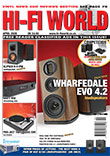Quadraphonics - Quad - The Rivals |
Page 3 of 4
QUAD - THE RIVALS STEREO QUADRAPHONIC SQ emerged from the CBS Technology Center in April 1971. Rear channel information was cut into the record using an intricate process which added double helical groove modulations, alongside vectored modulations for the front channels. By sensing the phase relationships between the channels, the SQ decoder attempted to send the appropriate signals to the appropriate loudspeaker. This idea of a ‘non-symmetrical phase matrix’ using phase shift networks to divide up the sounds was a very sophisticated one for 1971. The results weren’t spectacular, giving only around 3dB of channel separation between the front and rear speakers – due to the need to retain excellent left-to-right separation at the front. Later ‘logic decoders’ gave far better results. Any matrix quad system (SQ, QS/RM, EV-4) decoded any matrix-encoded record, but the results weren’t always consistent! QUADRAPHONIC STEREO Sansui introduced QS in February 1972. Like SQ and EV-4, it could decode any matrixed quad encoded record, and synthesise quad from a stereo source. A very close cousin was RM (Regular Matrix), which is said to be QS but without logic in the decoder. QS was often said to be dramatically better than SQ when synthesising quad from a stereo source, giving up to 20dB front to rear separation and 10dB from left to right. By 1973, Sansui had developed its SQ decoders with logic circuitry and a range of parameter adjustments to give ‘Vario-Matrix’. The quad cognoscenti generally agree this works very well, making stereo and matrixed quad discs sound vibrant and engaging. COMPATIBLE DISCRETE-4 CHANNEL A discrete four channel surround sound from vinyl, CD-4 pushed record manufacturing technology to the limit! A high frequency carrier signal (a la FM stereo) handled two extra channels of audio in RCA’s CD-4 Quadradisc system launched in May 1972. Super-fine grooves were cut into the vinyl to carry signals between 20-45kHz, which the CD-4 demodulator sensed and ‘downconverted’ to the audio band of around 100Hz-15,000kHz and sent to rear loudspeakers. The limitations of tonearms of the day created difficulties. Shibata styli needed tracking at less than 2g – routine today but fanciful back then. Mistreatment, dirt and worn styli simply wiped out the HF information. Finally, CD-4’s channel separation wasn’t obviously better than later matrix decoders, which were far easier to use. |






